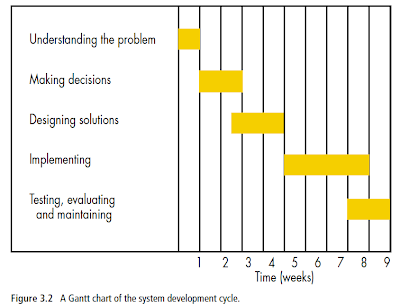If the preliminary investigation recommends further examination of a new system, a project plan is developed for the system. A project plan - organises the project by specifying who, what, how and when.
- It includes Gantt charts,
- scheduling of tasks, journal and diary entries,
- a funding management plan and
- a communication management plan.
The project leader starts by - breaking down the development of a new system into smaller tasks.
- They identify all the tasks, an estimate for the cost of each task and a schedule for each task.
Project leaders use information management software and project management software to construct and manage a project plan.
B.1 Information management software- Information management software helps individuals to manage information and schedule tasks.
- It allows email messages to be exchanged and organised.
- For example, all messages from the project leader could be put into a separate folder.
- Appointments, events and meetings are entered into an electronic calendar.
- These activities can be viewed by the day, week or month.
- Information management software allows users to store the names and addresses of individuals and organisations. All activities for each contact are recorded to form a journal.
- Journal entries are organised on a timeline to quickly locate information.
- Tasks in the project are assigned, sorted and organised so that the progress made on a task can be seen at a glance.
B.2 Project management softwareProject management software contains most of the features of information management software. It is a tool to plan, manage and communicate information efficiently in a large project. Project management software - allows projects to be joined,
- tasks to be split among team members, and
- for the project to be tracked over the Internet or via email.
- It provides analysis tools to assist with decision making, such as ‘what if’ questions.
Project management software contains- graphical tools such as Gantt charts.
- A Gantt chart is a popular way of managing a project.
- It provides a quick method of determining if the project is on schedule.
- Gantt charts are used in meetings to review progress and identify problems.
- A Gantt chart is a bar chart with each bar representing a task.
- The vertical axis lists the tasks and the horizontal axis shows the time frame (see Figure 3.2).
The success of a new system depends on accurate time estimates for each task. - If the schedule is unreasonable it will result in delays and additional costs.
- It may be necessary to extend the deadlines or reduce the scope of the system development.
- If the scope of the system development is reduced, a less comprehensive solution may result.
Some example Project Management Tools include: - https://sourceforge.net/projects/openproj/
- OpenProj is a Java-based open source project management tool developed at Projity by Howard Katz, Marc O’Brien and Laurent Chretienneau in 2007.
- In 2008, the company was acquired by Serena Software, and development has ceased thereafter.
- In May 2016, Serena was acquired by Micro Focus and has become one of its subsidiaries.
- In 2012, the original creators of OpenProj forked the abandoned code and developed ProjectLibre, which was initially released in 2012.
- https://sourceforge.net/projects/projectlibre/
- ProjectLibre is the leading open source alternative to Microsoft Project. It has been downloaded over 3,000,000 times in over 200 countries and has won InfoWorld "Best of Open Source" award. ProjectLibre is compatible with Microsoft Project 2003, 2007 and 2010 files. You can simply open them on Linux, Mac OS or Windows.
|
|

